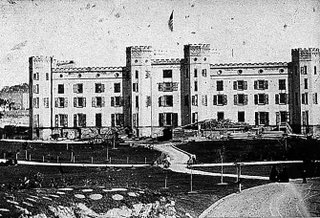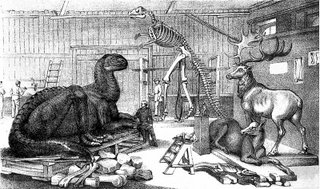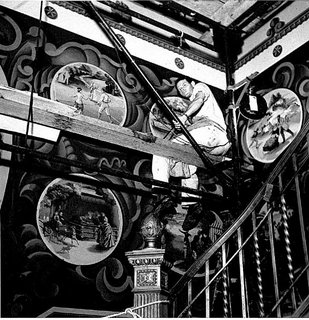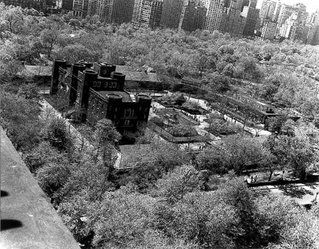The Arsenal AKA The Office (& The Beatnuts)
This is just a random amount of information I found about the building I work in. I love walking into the park and entering up the stairs everyday and I wanted to know more. Thank god for brochures!! Now I can always remember how kickass my job really is!

The Arsenal and the Menagerie, c. 1870
Located at
The Arsenal is one of two buildings within the park’s borders which predate the park itself (the other is a blockhouse at the north end dating from the War of 1812). It was built between 1847 and 1851 by the State of
Designed by architect Martin E. Thompson, the crenellated structure, originally stuccoed, and marked by a crenulated cornice, resembles a medieval fortress. Its doorway is guarded by cast-iron eagle made by Daniel Meeker Foundry of Newark, New Jersey.
The building’s military use proved shortlived. Between 1853 and 1856, the State seized the land under it for a public park. In 1957 the City purchased the Arsenal for $275,00.00, removed all arms, and established park administrative functions on the premises. Certain park advocates and urban observers felt this structure was a blight on the landscape, most notably diarist Geroge Templeton Strong who in 1859 referred to the “hideous
The Arsenal, 1864. Photo by: W.H. Guild Jr.
This was not to be, and over the ensuing decades the building served diverse roles. In 1857 the 11th police precinct was stationed there. The newly created
Beginning in 1859, a burgeoning menagerie was located in and around the Arsenal. Gifts or loans of animals by the likes of impresario P. T. Barnum, financier August Belmont and Civil War general William Tecumseh Sherman could be seen in outdoor cages and in the basement of the building. The "great insecurity and danger" of this arrangement, as well as the stench, resulted in the removal of the interior cages by 1871.
A Gallery of Art, later relocated to the former Convent of Mount St. Vincent at the park's north end, graced the first floor space. Prior to moving to the park's
Various designs for remodeling the Arsenal emerged over time. Jacob Wrey Mould, the Architect responsible for much of the ornamental detail at Bethesda Terrace and elsewhere in the park, remodeled the Arsenal interior in 1870. An Arsenal restaurant existed early in the 20th century; plans for its renovation appear in an official parks report of 1916. Also in that year the Parks Department considered demolishing the building altogether and relocating the weather bureau and police station to the Belvedere and Sheepfold (later Tavern on the Green) respectively.
At that time the City appropriated $75,000 for an overhaul of the Arsenal, including new central turrets and a clock, basement storage for "trees, plant and shrubs," and a conference room for park researchers (later a library).
Most of the space was set aside for Parks Department offices. During reconstruction an underground spring and a secret passage were discovered (the latter possibly from the building's days as an arsenal, for the undercover transfer of arms). The restoration was completed in 1924.
Allen Saalburg painting murals in the Arsenal Lobby, Central Park,
(southeast corner, east wall), 1936.
Having served off and on as the borough park offices, the Arsenal underwent another complete renovation in 1934 as the first and only headquarters of a citywide unified Parks Department. From his command posts at the Arsenal and at Randall's Island, Commissioner Robert Moses set about directing an unprecedented expansion of the parks system and the modernization of
In 1935-36 the Arsenal lobby murals were painted under the direction of Allen Saalburg. Saalburg researched images of old
The project was funded by the Federal Works Progress Administration. Also at this time, a new entryway was designed for the front of the Arsenal, including military drums over the doorway, and cast-iron musket replicas as supports for the banisters.
Bird's-eye view of the Arsenal, 1962
Over time the Arsenal has become a parks fixture, appearing on occasion in fictional feature films. In 1967 the Arsenal was designated an official New York City Landmark. The bronze eagles which presently flank the third floor entrance and conference room arrived in 1981; they were secured after repeated acts of vandalism necessitated their removal in 1962 from the
Since the early 1980s, the central chamber on the third floor of the building has been used as a gallery and space for public forums. Eight to ten exhibitions of fine arts and photography are mounted annually, and preference is given to shows concerned with the natural environment, urban issues and parks history. The gallery may be reserved for private and public functions.
------------------------------------------------------------------------------------------------ The Beatnuts are a hip hop crew from
The Beatnuts are a hip hop crew from Anyway, I have fallen back in love with this Latino Hip Hop Group. I have been listening to their album Street Level and suggest it to whoever might be reading this!






0 Comments:
Post a Comment
Subscribe to Post Comments [Atom]
<< Home